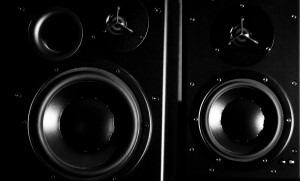
Monitoring is extremely important! If you can’t hear an accurate representation of what you are recording or mixing, chances are it’s not going to sound good on other systems. Monitoring is about more than just speakers, or headphones, it encompasses the entire playback system as well as the sound treatment of the room.
When I was ready to remodel the rooms I was going to use for my studio, I hired a professional studio acoustic consultant to come in and measure the area, figure out the spacing and dimensions for the walls we were installing or moving, and the proper layout for my console and monitoring position. We then added the appropriate sound treatment to the room (including a variety of products from RealTraps and GIK Acoustics) to even out the response of the room as much as possible (no room is perfect) and fine tune it until we got an accurate and pleasing sounding room to work in.
Even with the work we did to make the room sound good, I’ve always worked with several set of monitors, as well as headphones and other reference systems to check my work on. I like to have one big system that offers full range response, and extended low end, and then one “real world” type system that is more mid-range oriented to allow me to fine tune balances for what the typical consumer might here. In addition, I have a 5.1 monitoring system for surround sound mixing, and two of those speakers are also used as an “in between” set of stereo monitors. The subwoofer can also be switched in and out with any of the sets of speakers to check the very deep low end (or to see how a mix will sound on a big club system). Now that many people listen on headphones and earbuds, I have several pairs of headphones that I use as references. Plus, there are the cars, the various computer systems in the office, a boom box, TVs, and a few laptop computers.
I’ve been doing this long enough, and have had my setup long enough that I trust my ears and monitoring system in my studio, so that I don’t need to check on every system, but it’s nice to have the options!
Here’s what I’m using:
- DYNAUDIO BM15A Powered Monitors – Incredible sound with deep bass extension. My main monitors for dialing in the sounds and checking the low end. Deep bass extension and plenty loud enough for anyone!
- DYNAUDIO BM6A Powered Monitors (5) – A set of 5 of these great monitors for surround sound monitoring, or as my “in between” set for stereo monitoring. Can also use a couple of these in the tracking room for those who don’t like to wear headphones when they record.
- DYNAUDIO BM12S Powered Sub – A very powerful and deep subwoofer coupled with the other DynAudio monitors for both stereo and surround sound monitoring.
- AURATONE – Studio monitors for the real world. These “cubes” don’t have much high end or low end response to them, but they are the perfect monitors for checking midrange and for overall level balancing. These get used a lot during mixing!
- AUDIO TECHNICA ATH-M50 – A killer set of headphones that are my “go to” pair for checking my mixes. This is my personal set of headphones.
- AKG K240 Studio Headphones – Several pairs of these headphones for studio clients to use while recording.
- Ultrasone HFI 680s – Another prize that I won in the Sound On Sound Dave Pensado mixing competition. I still like my ATH-M50 headphones better, but this is a nice alternative for studio clients who need to hear a bit more bass.
- Sony MDR 7506 – I still have a few pairs of these headphones laying around, which used to be the main headphones I used for studio clients, until all the deaf hip-hop guys kept cranking them so loud they blew all the drivers! I could probably piece together a working pair, but they aren’t worth it any more. The AKG K240s are much more robust than the Sony’s and have easily interchangeable parts (although I have had to fix any of them yet).
- ProCo SWITCH WITCH – Handy rack mount passive 4 way switch for very clean and uncolored switching of up to 4 pairs of monitors. I have one switch assigned to each of my sets of monitor speaker pairs (BM15A, BM6A, and Aurtones), and another switch goes to the sub. Any combination can be on at any given time, so I can pair up the sub with any set of monitors.